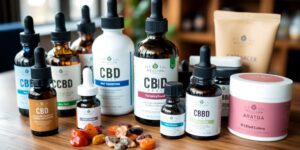Picking the right health and beauty products can feel like a maze. With so many options out there, it’s hard to know what really works for you. This guide will help you make sense of it all, from understanding your skin type to finding the best ingredients. Whether you’re looking for something to tackle dry skin or just want to try the latest trend, we’ve got you covered. Let’s get started!
Key Takeaways
- Know your skin type to pick the right products.
- Look for natural ingredients that suit your needs.
- Always read labels to avoid harmful stuff.
- Patch test new products to prevent reactions.
- Stay informed on the latest beauty trends.
Understanding Your Skin Type
Knowing your skin type is like having the secret code to amazing skin. It’s the first step in figuring out what products will actually work for you, and what will just end up clogging your pores or leaving you feeling drier than the Sahara. I used to just grab whatever was on sale, and my skin was a total mess. Now that I actually pay attention, things are so much better.
Identifying Oily Skin
Oily skin is pretty easy to spot. You’ll notice a shine, especially in your T-zone (forehead, nose, and chin), pretty much all the time. It’s like your face is permanently ready for a photoshoot, but not in a good way. Large pores are another giveaway, and you might be more prone to breakouts. I have a friend who swears blotting papers are her best friend. Here are some common characteristics:
- Shiny appearance
- Visible pores
- Tendency to develop blackheads and pimples
Recognizing Dry Skin
Dry skin feels tight and sometimes itchy. It can look flaky, especially in the winter. Moisturizer is your best friend, and you might find yourself reapplying it constantly. I used to think I just had sensitive skin, but turns out, it was just super dry. Here’s what to look for:
- Flakiness or scaling
- Tightness, especially after cleansing
- Itchiness
- Dull appearance
Combination Skin Characteristics
Combination skin is like the worst of both worlds. You’re oily in some spots (usually the T-zone) and dry in others (cheeks). It can be tricky to find products that work for everything. I have combination skin, and it took me forever to figure out a routine that didn’t make me either an oil slick or a flaky mess. It’s all about balance. If you’re looking for CBD products for your skin, make sure they are non-comedogenic.
Combination skin requires a tailored approach, addressing both oily and dry areas with different products. It’s about finding that sweet spot where your skin feels balanced and healthy, not too oily, not too dry.
Here’s a quick guide:
| Area | Characteristic | Treatment |
|---|---|---|
| T-zone | Oily | Light, oil-free products |
| Cheeks | Dry | Rich, hydrating moisturizers |
Essential Ingredients to Look For

When you’re trying to find the right health and beauty products, it’s easy to get lost in all the fancy packaging and big promises. But honestly, what really matters is what’s inside the bottle. Knowing which ingredients actually work can make a huge difference in how effective your routine is. Let’s break down some key things to keep an eye out for.
Natural Oils and Extracts
Natural oils and extracts can be super beneficial for your skin. They often provide hydration and nutrients without harsh chemicals.
- Look for oils like jojoba, argan, and rosehip. These are known for their moisturizing and anti-inflammatory properties.
- Extracts like aloe vera and chamomile can soothe irritated skin.
- Tea tree oil is great for acne-prone skin due to its antibacterial qualities.
Natural ingredients are often less likely to cause irritation, making them a good choice, especially if you have sensitive skin. They can also be more sustainable, which is a bonus for the environment.
Vitamins and Antioxidants
Vitamins and antioxidants are like a shield for your skin, protecting it from damage and helping it stay healthy.
- Vitamin C is a powerhouse for brightening skin and fighting free radicals.
- Vitamin E is a great moisturizer and helps protect against sun damage.
- Niacinamide (Vitamin B3) can reduce redness and improve skin texture. Check out plant-based skincare for more natural options.
Hydrating Agents
Keeping your skin hydrated is key to a healthy complexion. Dehydrated skin can look dull and can even make fine lines more noticeable.
- Hyaluronic acid is a must-have. It can hold up to 1000 times its weight in water, drawing moisture into the skin.
- Glycerin is another effective humectant, helping to keep skin hydrated and supple.
- Ceramides help to repair the skin barrier, preventing moisture loss.
| Ingredient | Benefit |
|---|---|
| Hyaluronic Acid | Intense hydration |
| Glycerin | Moisturizes and softens skin |
| Ceramides | Repairs and protects the skin barrier |
Evaluating Product Labels
Okay, so you’re standing in the store, staring at a wall of products. How do you even begin to choose? The secret weapon is right there on the bottle: the label. But let’s be real, those labels can be confusing. Here’s how to make sense of them.
Reading Ingredient Lists
This is where the magic happens, or doesn’t. The ingredient list is ordered from the highest concentration to the lowest. So, the first few ingredients are what you’re mostly getting. If water (aqua) is first, that’s good for hydration, but maybe not so great if you’re looking for something potent. Watch out for ingredients you know you’re sensitive to, and be aware that long lists aren’t always better. Sometimes, fewer, high-quality ingredients are preferable.
Understanding Product Claims
"Reduces wrinkles!" "Fights acne!" "Brightens skin!" These claims are everywhere, but how much can you trust them? Well, it’s complicated. The FDA regulates some claims, especially those related to medical conditions. But a lot of marketing language is just that: marketing. Look for words like "clinically proven" or "dermatologist tested," but even then, do your research. Check reviews and see if the claims seem realistic. Don’t fall for hype alone.
Recognizing Harmful Additives
Some ingredients are best avoided altogether. Here’s a short list to keep in mind:
- Parabens: These are preservatives that some people are sensitive to.
- Sulfates: These can be harsh and drying, especially for sensitive skin. Look for CBD products without sulfates.
- Phthalates: These are often found in fragrances and can be endocrine disruptors.
It’s impossible to be an expert on every single ingredient, but doing a little research on common offenders can make a big difference. There are plenty of resources online that can help you identify potentially harmful additives. Remember, knowledge is power when it comes to your health and beauty routine.
Here’s a simple table to help you remember:
| Additive | Potential Concern |
|---|---|
| Parabens | Sensitivity, hormone issues |
| Sulfates | Drying, irritation |
| Phthalates | Endocrine disruption |
The Importance of Patch Testing
Patch testing is something I never really thought about until I had a major reaction to a new face cream. My skin was red, itchy, and just generally angry. Now, I’m a firm believer in testing everything before slathering it all over my face. It’s a simple step that can save you from a lot of discomfort and potential skin damage. Trust me, it’s worth the extra few minutes.
How to Conduct a Patch Test
Okay, so how do you actually do a patch test? It’s pretty straightforward.
- Choose a small area of skin. The inside of your elbow or behind your ear are good spots because they’re usually more sensitive.
- Apply a small amount of the product to that area.
- Cover it with a bandage, if you want, but it’s not always necessary.
- Wait 24-48 hours. Keep an eye on the area for any signs of irritation. If you’re testing something that you’ll be washing off, like a cleanser, follow the product instructions for how long to leave it on, then rinse it off and observe the area.
Signs of Allergic Reactions
Knowing what to look for is key. Here’s what might indicate an allergic reaction:
- Redness
- Itching
- Burning
- Swelling
- Hives or rash
If you notice any of these, wash the product off immediately with mild soap and water. Don’t use the product again! It’s not worth the risk. I had all of these when I tried that new face cream, and it was not fun. I wish I had done a simple patch test first.
When to Seek Professional Advice
Most of the time, a mild reaction will clear up on its own in a day or two. But sometimes, things can get more serious. You should see a doctor or dermatologist if:
- The reaction is severe (lots of swelling, difficulty breathing, etc.).
- The reaction doesn’t improve after a few days.
- The reaction spreads beyond the initial test area.
- You’re not sure what’s causing the reaction.
Patch testing is a simple yet effective way to prevent adverse reactions to new health and beauty products. It’s a small investment of time that can save you from significant discomfort and potential skin damage. Always prioritize your skin’s health by taking this precautionary step before fully incorporating a new product into your routine.
Choosing Products for Specific Concerns
It’s easy to get lost in the sea of health and beauty products. Figuring out what actually works for your skin can feel like a never-ending quest. Let’s break down how to pick the right stuff for common issues.
Acne Treatment Options
Dealing with acne? You’re not alone. There are tons of products out there, but it’s important to know what to look for.
- Start with gentle cleansers: Harsh soaps can actually make acne worse.
- Consider active ingredients: Look for things like salicylic acid or benzoyl peroxide. These help unclog pores and kill bacteria.
- Don’t overdo it: Using too many products at once can irritate your skin. Introduce new products slowly.
Finding the right acne treatment is often about trial and error. What works for one person might not work for another. Be patient and pay attention to how your skin reacts.
Anti-Aging Solutions
Thinking about anti-aging? It’s all about protecting your skin and boosting collagen.
- Sunscreen is key: Seriously, wear it every day. It’s the best way to prevent wrinkles.
- Retinoids can help: These are vitamin A derivatives that boost collagen production. Start with a low concentration and use it at night.
- Antioxidants are your friends: Look for serums with vitamin C or E. They protect your skin from damage.
The most effective anti-aging routine is consistent and tailored to your skin’s needs.
Sensitive Skin Formulations
If you have sensitive skin, you know the struggle. Everything seems to irritate it. The key is to keep things simple and gentle.
- Avoid fragrances and dyes: These are common irritants.
- Look for hypoallergenic products: These are less likely to cause a reaction.
- Patch test everything: Before slathering a new product all over your face, test it on a small area first.
| Ingredient | Why It’s Good for Sensitive Skin |
|---|---|
| Ceramides | Help repair the skin barrier |
| Hyaluronic Acid | Hydrates without irritation |
| Aloe Vera | Soothes and calms inflammation |
If you’re looking for CBD products to help with skin issues, make sure to do your research and choose reputable brands. Some people find that CBD can help with inflammation and redness, but it’s not a cure-all.
Sustainable and Eco-Friendly Choices
It’s getting easier to make choices that are better for the planet, even with health and beauty products. More and more companies are realizing people care about this stuff, and they’re stepping up. It’s not just a trend; it’s about being responsible.
Biodegradable Packaging
Packaging is a big problem. So much of it ends up in landfills. Biodegradable packaging is designed to break down naturally, which is way better than plastic that sticks around forever. Look for terms like "compostable" or "biodegradable" on the label. Some brands are even using plantable packaging with seeds embedded in it! That’s a cool way to reduce waste and give back to the environment. It’s a win-win. Consider eco-friendly packaging when choosing products.
Cruelty-Free Certifications
Nobody wants animals to suffer for beauty. Cruelty-free certifications mean a product wasn’t tested on animals. Look for logos like the Leaping Bunny or PETA’s cruelty-free bunny. It’s important to know that "cruelty-free" doesn’t always mean "vegan" (no animal ingredients), so check the ingredient list if that’s important to you.
Here are some common cruelty-free certifications:
- Leaping Bunny
- PETA-Approved
- Choose Cruelty Free (CCF)
Organic Ingredients
Organic ingredients are grown without synthetic pesticides or fertilizers. This is good for the environment and can also be better for your skin, especially if you have sensitivities. Look for certifications like USDA Organic or COSMOS Organic. Organic farming practices also promote soil health and biodiversity. It’s worth noting that a product can be labeled "organic" even if only some of its ingredients are organic, so read the label carefully.
Choosing products with organic ingredients supports sustainable agriculture and reduces your exposure to potentially harmful chemicals. It’s a small change that can make a big difference.
Here’s a quick guide to understanding organic percentages:
| Percentage | Label |
|---|---|
| 95-100% | "Organic" |
| 70-94% | "Made with Organic Ingredients" |
| Below 70% | Can list organic ingredients separately |
Budgeting for Your Health & Beauty Routine
Finding Affordable Options
Okay, so you want to look good without emptying your bank account? Totally doable. The trick is to be smart about where you spend your money. Don’t fall for the hype around super expensive brands right away. Start by checking out drugstore brands – some of them have seriously stepped up their game. Look for sales and discounts; most stores have them regularly. Also, consider buying in bulk when it makes sense, especially for things like shampoo or face wash that you use every day. Don’t be afraid to try store brands; often, they’re just as good as the name brands but way cheaper.
Investing in Quality Products
It’s tempting to buy the cheapest of everything, but sometimes, it pays to spend a little more. Think about it this way: a really good skin serum might last longer and work better than a cheap one, so you end up using less product overall.
Here’s a few things to consider investing in:
- Sunscreen: Seriously, don’t skimp on this. It’s your best defense against aging and skin cancer.
- A good cleanser: A gentle, effective cleanser sets the stage for everything else.
- One or two treatment products: Maybe a retinol or a vitamin C serum, depending on your skin concerns.
Don’t feel pressured to buy everything at once. Start with the basics and slowly add in other products as you can afford them. It’s better to have a simple routine with quality products than a complicated routine with cheap stuff that doesn’t work.
DIY Alternatives
Want to save even more money? Try making some of your own products! It’s easier than you think. There are tons of recipes online for things like face masks, scrubs, and even hair treatments. Just make sure you do your research and use safe, natural ingredients. For example, you can make a simple face mask with honey and oatmeal, or a hair mask with coconut oil and avocado. Not only is it cheaper, but you also know exactly what’s going into your products. Plus, it can be kind of fun! Just be careful and test everything on a small area of skin first to make sure you don’t have any reactions.
Staying Updated on Trends

It’s easy to get stuck in a rut with your health and beauty routine. What worked last year might not be the best thing now. New ingredients, technologies, and even perspectives are always popping up. Staying in the loop can help you make better choices and maybe even discover something amazing for your skin or overall health.
Following Influencers and Experts
Social media can be a mixed bag, but it’s also a great way to find people who really know their stuff. Look for influencers and experts who are transparent about their recommendations and don’t just push products. Authenticity is key.
- Check their credentials – are they dermatologists, cosmetologists, or have some other relevant background?
- Do they disclose sponsored content?
- Do their recommendations seem balanced and realistic?
Reading Reviews and Blogs
Before you drop cash on a new serum or gadget, see what other people are saying. Reviews and blogs can give you a sense of whether a product lives up to the hype. I always check multiple sources before making a decision. For example, I was looking at CBD oils and found a lot of helpful information in online reviews.
It’s important to remember that everyone’s skin is different. What works for one person might not work for you. But reading a range of opinions can help you get a better sense of a product’s potential benefits and drawbacks.
Attending Beauty Expos
If you really want to immerse yourself in the world of health and beauty, consider going to a beauty expo. These events are like giant playgrounds for beauty lovers. You can try new products, attend workshops, and meet brand representatives. Plus, you often get exclusive deals and samples.
Here’s what you can expect:
- Product demonstrations
- Expert panels
- Networking opportunities
Creating a Personalized Routine
Okay, so you’ve got all these products, you know your skin type, and you’re ready to go. But just slapping everything on your face at random isn’t going to cut it. You need a personalized routine that works for you. It’s all about figuring out what your skin needs and when it needs it.
Morning vs. Evening Regimens
Think of your skin like you think of your day. Mornings are for prepping and protecting, evenings are for repair and recovery. In the morning, you want to focus on cleansing, hydrating, and protecting your skin from the sun. A light cleanser, a hydrating serum, and sunscreen are your best friends. At night, you can bring out the big guns: retinoids, heavier moisturizers, and anything that helps your skin repair itself while you sleep.
Layering Products Effectively
Layering is key, but there’s a method to the madness. The general rule is to apply products from thinnest to thickest. This helps ensure that each product can properly absorb into your skin. Start with serums, then move on to lotions, and finish with creams or oils. And don’t forget to give each product a minute or two to sink in before applying the next one.
Adjusting for Seasonal Changes
What works in the summer might not work in the winter. When the weather gets colder, your skin tends to get drier, so you might need to switch to a heavier moisturizer or add a hydrating mask to your routine. In the summer, you might want to use lighter products to avoid clogging your pores. Pay attention to how your skin feels and adjust accordingly.
Creating a personalized routine is an ongoing process. It’s not something you set and forget. You need to be willing to experiment, adjust, and listen to your skin. What works for someone else might not work for you, and that’s okay. The goal is to find a routine that makes your skin happy and healthy.
Here’s a simple example of how your routine might change:
- Spring/Summer: Light cleanser, Vitamin C serum, lightweight moisturizer, SPF.
- Fall/Winter: Creamy cleanser, Hyaluronic acid serum, rich moisturizer, facial oil.
And remember, consistency is key. Sticking to a routine, even a simple one, is better than sporadically using a bunch of fancy products. Regular use of CBD for wellness can also help maintain balance and improve overall skin health.
Building a routine that fits your life can make a big difference. Start by thinking about what you want to achieve and when you can do it. Whether it’s exercise, studying, or relaxing, having a plan helps you stay on track. For more tips on how to create a routine just for you, visit our website!
Wrapping It Up
So, there you have it! Picking the right health and beauty products doesn’t have to be a headache. Just remember to think about your own needs and what works for you. Check out reviews, maybe ask friends for their favorites, and don’t be afraid to try new things. It’s all about finding what makes you feel good. And hey, if something doesn’t work out, that’s okay too! Just keep experimenting until you hit the jackpot. Your routine should be all about you, so make it fun and enjoy the process!
Frequently Asked Questions
What is my skin type?
To find out your skin type, wash your face and wait for an hour. If your skin feels greasy, you likely have oily skin. If it feels tight or flaky, you probably have dry skin. If it’s a mix of both, you have combination skin.
What ingredients should I look for in skincare products?
Look for natural oils like coconut or jojoba, vitamins like C and E, and ingredients that hydrate your skin, such as hyaluronic acid or glycerin.
How do I read product labels?
Start by looking at the ingredient list. The first few ingredients are the most important. Make sure to check for any claims the product makes, like ‘hypoallergenic’ or ‘non-comedogenic’.
Why is patch testing important?
Patch testing helps you see if a product will cause a reaction on your skin. Apply a small amount to a hidden area and wait 24 hours to check for redness or irritation.
What should I do if I have acne?
For acne, look for products with salicylic acid or benzoyl peroxide. These ingredients can help clear up breakouts and keep your skin clear.
How can I choose eco-friendly beauty products?
Look for products that use biodegradable packaging, are cruelty-free, and contain organic ingredients. These choices are better for the environment.
How do I create a budget for beauty products?
You can find good products that don’t cost a lot by shopping sales or looking for drugstore brands. Sometimes, spending a little more on quality products is worth it, too.
How can I stay updated on beauty trends?
Follow beauty influencers on social media, read blogs and reviews, and attend beauty events to learn about the latest trends and products.






